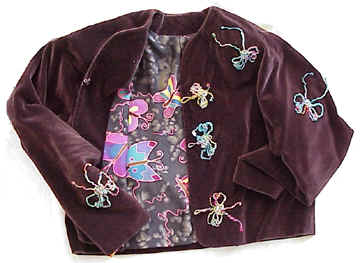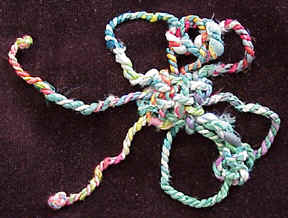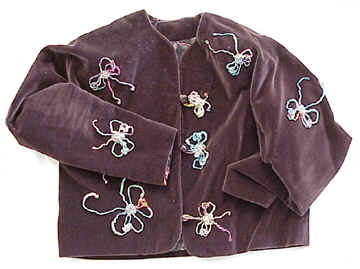Possible uses:
Butterfly pin, adornment on jacket, closures for rag woven jackets, jewelry.
I chose to use leftover silk scraps from numerous projects. The
cut strips varied in length from 8 inches to one yarn. The weight of the silk varied from
6 mm habotai to 10 mm jacquard.

Because of my
study on knotting, I knew a soft spin would not be suitable. I put as much twist on the
scraps as they could handle. As sample S6 shows, a
single is not appropriate for knotting and is not stable. I decided to make balanced two
ply. This gave a nice weight cord, was round and balanced. These were the criteria I
discovered during the learning of the basic knots.
As samples S7 through S9 reveal, straight and cross grains give the
smoothest finish on the cord and circular the roughest. These samples were made from a 10
mm pin dot jacquard.

After the cord was spun, butterfly pan chang knots were tied. Each was given its own personality by how tight the knot was pulled. From some of the heavier cord spun mainly from the jacquard I knotted special butterfly closures. These were adapted from the pan chang butterfly knots and standard frog closures with button knots.
When the samples
were knotted they were more bulky than I wanted. The button knots did not look very good
in this cord (sample S10). I started again with 6
mm habotai cut into 3/4 inch strips and 8 mm habotai cut in 1/2 strips. All were cut on
the cross grain of the fabric. The two weights of fabric went perfectly together when cut
at that width. This cord I did not spin with as tight a twist as the larger cord because I
wanted to be able to get a needle into it. The butterfly knots tied much nicer, had more
definition and looked more like dainty butterflies (sample
S11). The button knots (sample S11) still looked too flimsy. I decided not to use the
button knot but use the butterflies as loops for standard buttons.
Even with the softer twist, it was difficult to get a needle into
the butterflies. The butterfly pan chang knots were sewn onto the velvet before the silk
lining was sew in.
Section 2--Description
The fiber of choice was 6 mm habotai cut into 3/4 inch strips
and 8 mm habotai cut into 1/2 inch strips. The silk was all cut on the cross grain
of the fabric.
I spun a Z twist single with a twist angle close to 45 degrees on
a bulky spinner, ratio 3:1. Carefully controlling the twist, it was plied into a
balanced two ply.
After the cord was spun, butterfly pan chang knots were tied.
Each was given its own personality by how the knot was manipulated.
The silk cord knots were sewn onto the velvet before the lining
was sewn in. The lining of the jacket is hand painted pin do jacquard.
